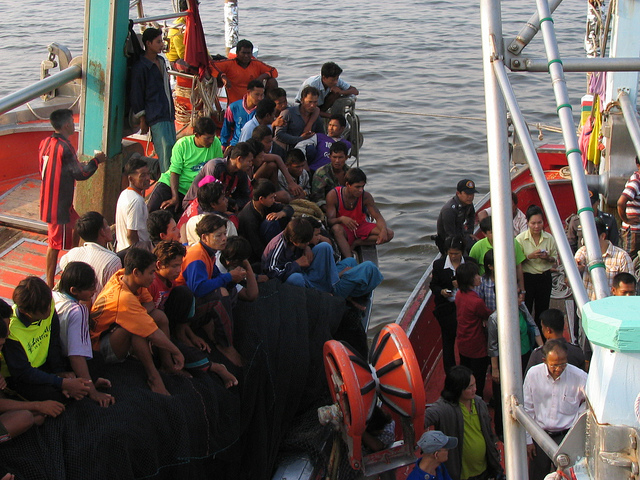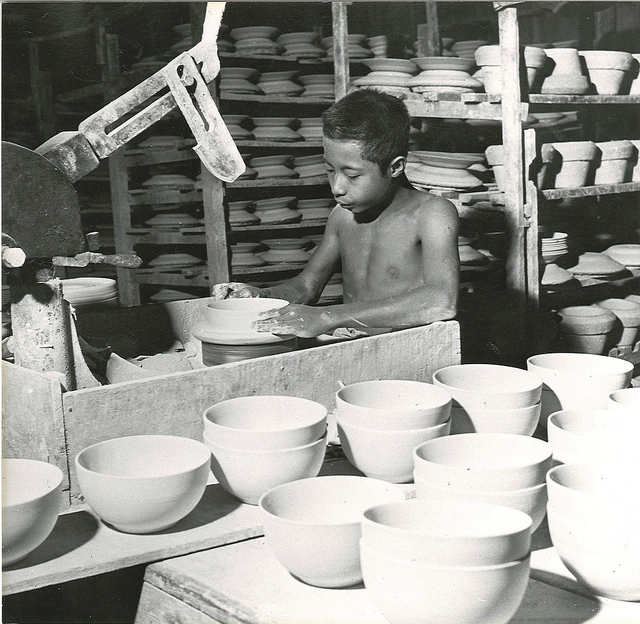A lack of legitimate job opportunities in Myanmar has contributed to a shadow economy of informal or illegal labor, operating both within and outside the country’s national borders. Informal labor is prevalent in a range of economic sectors and affects a broad spectrum of demographics.
Human Trafficking

Migrant workers, mainly from Myanmar and Cambodia, are the main workforce for Thailand’s fishing industry. Photo by International Labour Organization, taken on February 4, 2015. Licensed under CC BY-NC-ND 3.0.
Traditionally working in border regions, where the government’s oversight is limited, human trafficking networks in Myanmar now extend to the country’s major cities.
Although Myanmar people are trafficked to other Asian countries, such as China, Bangladesh, Malaysia, Korea and Macau, the primary destination is Thailand. Approximately 600,000 Burmese migrants are registered to work in Thailand, but many more are there illegally.1
Many people are trafficked to Thailand to work in agriculture, fishing, construction, factories, domestic work and the sex industry. Local traffickers use deceptive tactics to recruit men into forced labor on palm oil and rubber plantations or in jade and precious stone mines.2
Women and girls are primarily subjected to sex trafficking, domestic servitude, or forced labor in garment manufacturing. Trafficking groups typically lure or force women and children into sex work, primarily in Thailand and China.5 Children are subjected to sex trafficking or to forced labor in teashops, the agricultural and construction sector, and in begging, at times through debt bondage. Both children and adults are subjected to forced domestic servitude. 3
A global index on modern slavery stated that some 30 million people are enslaved worldwide and 384,000 people are enslaved in Myanmar.4 Modern slavery is when one person possesses or controls another person in such a way as to significantly deprive that person of their individual liberty, with the intention of exploiting that person through their use, profit, transfer or disposal.5 Myanmar enacted the Anti-Human Trafficking law in September 2005. According to official statistics, the government exposed 1,168 cases between 2006 and April 2015, rescuing more than 2,000 victims and arresting 2,106 traffickers. 6
Child Labor

Burmese boy making pottery. Photo by International Labour Organization, taken on October 17, 2013. Licensed under CC BY-NC-ND 3.0.
Child labor is widespread problem throughout Myanmar. Many of the children are recruited by agents and employed in tea shops or as restaurant attendants, street vendors, manual labor, waste collectors or beggars, in food processing and light manufacturing industries, and on farms in rural areas.7
The estimated number of children in Myanmar was 12.146 million in 2014, with about 10.5 percent of this number working, totalling 1.279 million working children. The definition of working children in the 2014 Myanmar census is: “those whom during the past seven days have been engaged for one hour or more, on a full-time or part-time basis, paid or unpaid, in the production of goods and services that have a market value.”8
According to the statistics from the International Labor Organization (ILO), 40 percent of children in hazardous workplaces were in environments contaminated by dust and fumes, while 16.5 percent were working with dangerous tools. A further 11.2 percent of children were exposed to extreme cold or heat in their working environment, 9.8 percent were exposed to dangerous chemicals and 9 percent were exposed to other workplace hazards.9
In Myanmar, over 77 percent of children between 5 and 17 years are attending school, This privilege does not extend to the majority of children in the labor force, with only 0.3 percent of working children being able to attend school, according to the statistics from the International Labor Organization (ILO).10
Commercial Sex Labor
There are an estimated 70,000 sex workers in Myanmar. About 8 percent of them are living with HIV, reported The Myanmar Times.11
Sex workers in Myanmar are mainly women, but homosexual and heterosexual men also provide sexual services. Child prostitution involves young girls and an increasing number of boys.
In many cases, brokers promising high-paying jobs lure women to distant foreign cities. The brokers regularly charge the women for transportation, food and other costs of living, in exchange for helping the women find work. In some cases, brokers trick women into becoming prostitutes, promising high-paying jobs without informing women of the actual work.12
In Myanmar the Suppression of Prostitution Act of 1949 stipulates that the act of soliciting or seducing in public is illegal, with offenders facing one to three years of imprisonment. The punishment is aimed solely at the sex workers and clients are not punished under the law.13
In addition to laws against prostitution, Myanmar has laws protecting minors and specifically prohibiting child prostitution. However, these laws are not enforced and many women under the age of 18 work as prostitutes.
References
- 1. Myanmar labour force, child labour and school to work transition survey 2015 View source
- 2. U.S. Department of State; Diplomacy in Action : https://www.state.gov/j/tip/rls/tiprpt/countries/2016/258735.htm
- 3. U.S. Department of State; Diplomacy in Action : https://www.state.gov/j/tip/rls/tiprpt/countries/2016/258735.htm
- 4. The Irrawaddy News : http://www.irrawaddy.com/news/asia/384000-people-burma-modern-day-slaves-report.html
- 5. WALK FREE; Modern Slavery Facts: https://www.walkfree.org/modern-slavery-facts/
- 6. Global Times News: http://www.globaltimes.cn/content/921225.shtml
- 7. The Myanmar Centre for Responsible Business http://www.myanmar-responsiblebusiness.org/pdf/SWIA/Oil-Gas/10-Labour.pdf
- 8. Myanmar labour force, child labour and school to work transition survey 2015 View source
- 9. Myanmar labour force, child labour and school to work transition survey 2015 View source
- 10. Myanmar labour force, child labour and school to work transition survey 2015 View source
- 11. The Myanmar Times : http://www.mmtimes.com/index.php/lifestyle/21635-inside-the-world-of-male-sex-workers.html
- 12. Rehmonnya; The official website of Human Rights Foundation of Monland: http://rehmonnya.org/archives/1156
- 13. Rehmonnya; The official website of Human Rights Foundation of Monland: http://rehmonnya.org/archives/1156

